Consequently, one could argue that social media is serving its true purpose now more than it ever did before – to bring people together over distance (whether that’s around the world or down the road).
Across the board, social apps have reported increased engagement as users find themselves with more spare time to scroll, post and share content.
The type of content we’re consuming has also changed. According to GlobalWebIndex, 48% of US and UK consumers use social media to read more news as a result of the outbreak, meaning platforms now have even greater responsibility to prevent the sharing of misinformation.
So, as usage soars, how are the likes of Facebook, Instagram and Twitter responding in order to help its users be better connected, informed and supported in the face of a global pandemic?
How has usage changed?
In March of this year, Facebook’s Daily Active Users (DAUs) and Monthly Active Users (MAUs) saw an 11% and 10% year-on-year increase respectively, according to its Q1 2020 results, reflecting an uplift in engagement triggered by users following stay-at-home orders. Video calling on Facebook Messenger and sister brand WhatsApp has almost doubled in some areas hardest hit by the virus.
Meanwhile, Facebook says that it “experienced a significant reduction in the demand for advertising” during the last three weeks of the quarter as brands began pulling their campaigns to save money – however, since then, things have levelled out more as brands recovered from the initial shock of the crisis and started to cautiously resume some ad activity (and take advantage of the high levels of social media engagement during lockdown).
The launch of Facebook’s Shops feature is also likely to play a part in revitalising advertising on Facebook as brands move to promote their new ecommerce outlets.
How is it supporting its users in light of Covid-19?
Facebook appears to be using the coronavirus outbreak to emphasise the sense of community the platform can create, which was one of the driving forces of its creation all those years ago.
Its Covid-19 Information Centre is one of the most prominent and useful changes the platform has seen since the beginning of the coronavirus pandemic. Accessible directly from the top of your newsfeed, or from the main menu, the feature is an expanded adaptation of its ‘community help’ function which was originally designed to help communities offer aid after localised disasters.
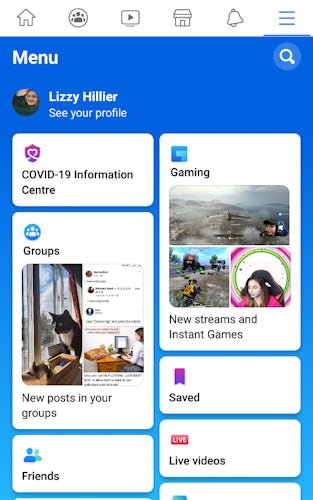
Facebook has expanded its ‘community help’ function into a fully-fledged coronavirus information centre. (Image via Facebook)
The Information Centre is personalised to prioritise conversations in your general area, based on your phone’s location, and is divided into sections for ease of navigation. It begins with a selection of ‘latest updates’ including real-time numbers of coronavirus cases and deaths in your region and globally, as well as a short-form summary of latest news.
A range of helpful links follows, including to the government website, the official Facebook pages and websites of recognised health organisations, and a handy pop-up containing common coronavirus prevention tips (such as hand washing).
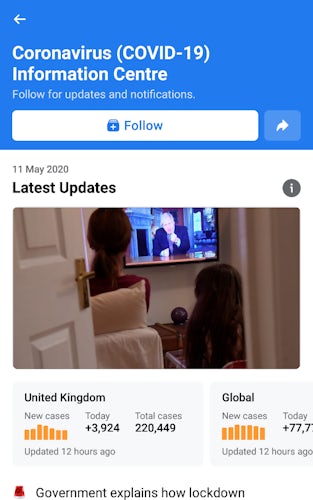
Localised coronavirus stats and updates on Facebook. (Image via Facebook)
Facebook has clearly made the effort to ring-fence an area of its platform for reliable news sources, making it more difficult for misinformation to gain traction – as long as it doesn’t make an unwanted appearance in users’ personal newsfeeds.
Perhaps the most unique feature of all is the ability to ‘offer and request help’, which has a dedicated page that users can filter through based on things like distance to their current location and type of request (e.g. baby supplies, food, transport and so on). This helpful UI makes it as easy as possible to support those in need while taking into account the individual circumstances of both parties. For example, I don’t own a car, so I would filter by requests that are closest to me to ensure I am able to fulfill my offer to help.
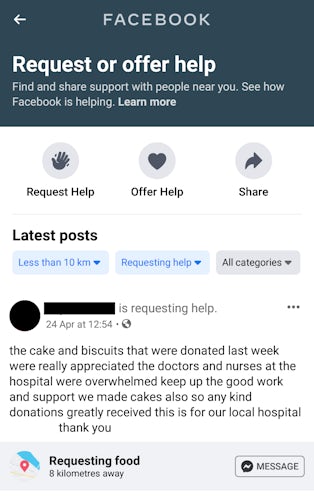
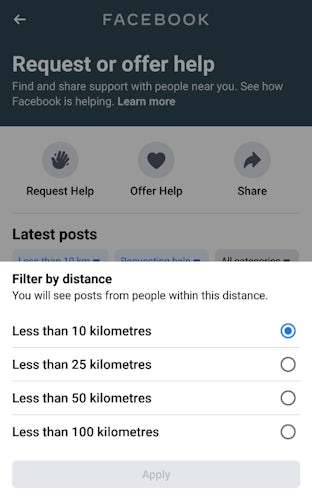
Facebook’s ‘request or offer help’ feature allows users to connect with worthwhile causes in their local area. (Image via Facebook)
Aside from the Covid-19 Information Centre, Facebook has launched a new video chat feature called ‘Messenger Rooms’ – a move likely made to rival newly-popular video conferencing tools like Zoom and Houseparty. Users will be able to create a ‘room’ through their Facebook or Messenger apps and invite up to 50 people to join via video chat, even if they don’t have a Facebook account.
The platform has also adopted smaller additions such as a new ‘caring’ reaction that better captures the empathy that many want to express than the standard ‘love’ reaction. It also recently announced that it will be offering free ads for global health organisations in order to help users find more reliably sourced information.
Facebook’s practical response to the outbreak supports its ‘grown up’ image and reflects the needs of its progressively more mature user base, focusing more on helping its users find the information they need than keeping them entertained.
TikTok
How has usage changed?
The addictive escapism of short-form video is providing much-needed relief for TikTok’s users, as it quickly becomes the social app that has defined this period of global crisis, from a UGC perspective above all others.
Since the outbreak began, there has been a notable spike in global downloads – 315 million in Q1 2020 alone, in fact – making it the most downloaded mobile app in any quarter ever, according to SensorTower. It is now thought that TikTok has surpassed 2bn lifetime downloads.
Lifetime user spending has hit $456.7 million, which is more than 2.5x that of spending levels seen since it reached 1.5 billion downloads, suggesting a steep upward trend in this metric. China is the most willing to spend money via the platform, reaching around $331 million, while the US and UK rank second and third ($86.5 million and $9 million respectively).
TikTok was clearly popular before the coronavirus outbreak, but recent circumstances have boosted its appeal amongst a wider demographic than its typically young audience. We’ve seen an increasing number of Millennial TikTok stars, and even Boomers are getting in on the action as they seek new ways of sharing their creativity with family, friends and strangers. As a result, TikTok released its first UK TV ad earlier in May focusing on ‘making the most of right now’.
How is it supporting its users in light of Covid-19?
While TikTok has integrated a few new features into its platform, many of them are quite subtle so as not to distract from the full-screen video interface that makes it so engaging.
The most noticeable of these is a small shield icon, permanently placed at the top right hand corner of the feed, as well as a thin banner across the bottom if the content you’re viewing contains hashtags related to the virus – for example ‘#coronavirus’, ‘#lockdown’ or ‘#quarantine’.
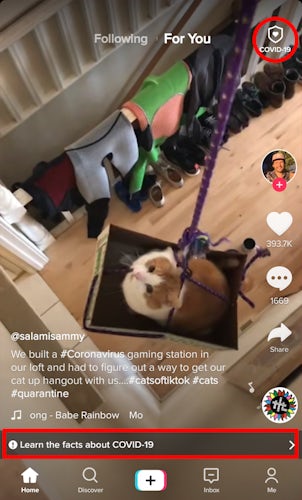
TikTok videos display an informational banner at the bottom if the content contains coronavirus-related hashtags, such #lockdown or #quarantine. (Image via TikTok)
Both of these direct to a clean-cut landing page where users can find videos about the pandemic, with those posted by trusted resources bumped up to the very top.
There are also three simple buttons – ‘Protect yourself’, ‘Mythbusters’ and ‘Q&A’ – which lead to various pages with easy to read copy written by the World Health Organisation explaining basic facts and advice.

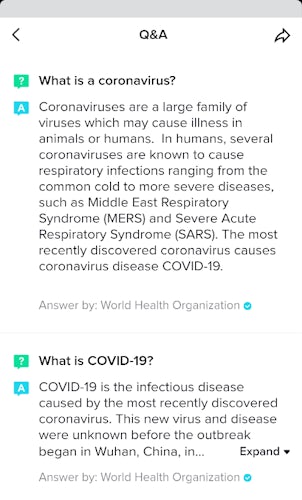
TikTok features Q&A-style content on Covid-19 authored by the World Health Organisation. (Images via TikTok)
Although the range of resources available to TikTok users is not as comprehensive as that of Facebook’s Covid-19 Information Centre, for example, the way in which it is presented is clear, simple and to-the-point, and remains mostly focused on its popular video content. Moreover, the inclusion of straightforward copy, produced in partnership with the WHO, will make sense to readers of all ages – in particular, the typically younger audience that populates the platform.
We can somewhat forgive TikTok for relying on user-generated content and (reliable) third-party sources in this instance, as the purpose of the platform is more to entertain than to inform, unlike say, Facebook or Twitter. Ultimately, TikTok’s users are there to watch light-hearted videos, not read the latest news updates.
Instead, the reason TikTok has become a social media sensation during this crisis is because the users themselves provide support and distraction for each other, posting about their daily lives, funny moments in lockdown and how cute their cats are.
Aside from the coronavirus landing page, TikTok has said that it is “donating prominent in-feed ad space to trusted organisations and local health authorities” and “does not allow ads that reference coronavirus, including when promoting products or services, to create a sense of fear, or to cause widespread offense”. There’s also a short notice that appears when searching for the hashtag #coronavirus, which reminds users to verify facts using trusted sources and to report content if they believe it violates the TikTok community guidelines.
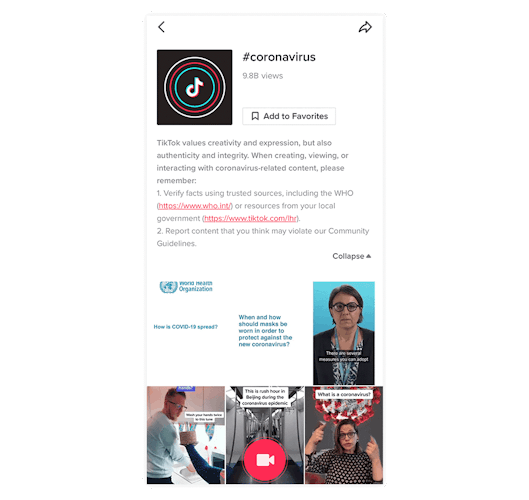
TikTok’s coronavirus hashtag encourages users to verify facts and report any suspect content. (Image via TikTok)
How dating apps are innovating with new features in response to coronavirus
YouTube
How has usage changed?
While no official figures have been released on user behaviour since Covid-19, Sundar Pichai, CEO of Alphabet and Google, described seeing ‘strong momentum’ on YouTube’s platform.
During Alphabet’s Q1 2020 earnings call he stated, ‘People are turning to YouTube. Our watchtime has increased across the board. People are also looking for authoritative news content. Viewership on YouTube has increased significantly compared to last year, too.’
Meanwhile, CFO Ruth Porat claimed that, by the end of March, YouTube’s ad revenue growth had ‘decelerated to a year-on-year growth rate in the high single digits’ and noted that ‘the second quarter will be a difficult one’ for advertising across its platforms. However, total ad revenue for the first quarter reached $4.04 billion, compared to $3.03 billion during the same period last year – a 33% year-on-year rise.
How is it supporting its users in light of Covid-19?
In March, YouTube launched a new campaign called #WithMe, to encourage users to share their skills and hobbies with viewers from around the world while they’re confined to their homes. This includes anything from live workouts to crafts, makeup tutorials, studying, cleaning and cooking.
YouTubers can post videos with the hashtag for a chance to be included on its main homepage alongside other newly featured sections like coronavirus news. As a result, YouTube attempts to achieve a sense of togetherness, helping viewers learn something new, keep up with schoolwork, be productive or practice mindfulness during this stressful time.
During the two weeks prior to the campaign launch, daily views of content containing #WithMe spiked by 600% compared to average viewership throughout the rest of the year, and as such became a strong springboard from which to begin promoting the hashtag officially.
YouTube’s #WithMe campaign is a fantastic example of a platform calling on its best creators to produce content that people will find genuinely useful, without necessarily reminding them of the coronavirus every time they click the play button.
Meanwhile, information is readily available for those that arrive at the platform to find the latest news and updates on the pandemic. As I described earlier, there are clear ‘recommended’ coronavirus categories displayed on the main homepage, containing playlists from the NHS and various news publications to help keep users up to date with the national and global situation.
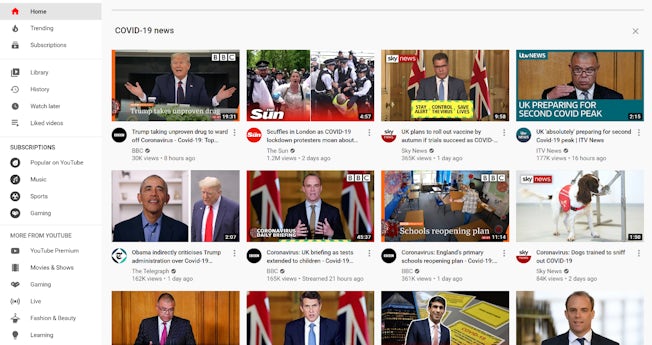
YouTube is featuring reputable news publications prominently on its homepage. (Image via YouTube)
Similarly to many other platforms mentioned here, YouTube has also ensured that official news sources and health organisations appear first on search results for coronavirus, complete with a ‘health information panel‘ at the top directing the user to the NHS website. The same banner appears under any video content tagged with such search terms.
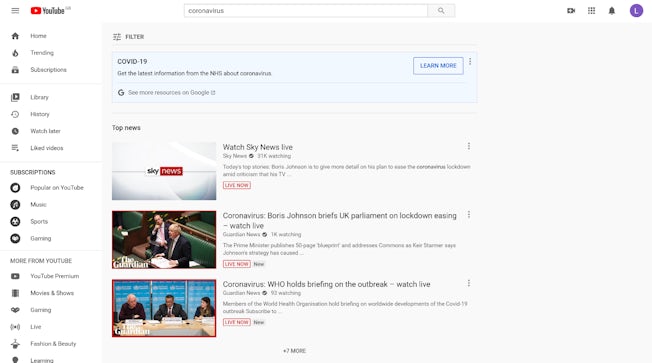
Search results page for ‘coronavirus’ with health information panel. (Image via YouTube)

A ‘health information panel’ appears under video content. (Image via YouTube)
How will Google’s new features for businesses impact search marketing after the Covid-19 crisis?
How has usage changed?
Despite many influencers having been forced to halt paid campaigns, engagement on sponsored Instagram posts significantly increased in March, according to influencer marketing company Obviously. Campaign impressions surged by 22% for Q1 compared to those of Q4, while daily likes on #ad posts rose by 76% over a two-week period during mid-March.
SproutSocial has also recorded changes in usage behaviour when it comes to the time of day. It appears that users are much more likely to check their Instagram feeds during working hours than they did before the outbreak, with a more substantial drop-off in activity after 6pm.
Meanwhile, Instagram Live has become particularly popular during the pandemic, Facebook has claimed. For example, in Italy, one of the worst affected countries in the European region, Instagram Live views doubled in just one week during March.
How is it supporting its users in light of Covid-19?
Instagram has added several updates, many of which help to prevent the spread of misinformation about the virus.
Using its third-party fact-checkers, the platform is actively downranking posts and stories that have been flagged as false to prevent them from appearing high up on its Explore page. Accounts featuring coronavirus related content are also being removed from recommendations for the same reason, unless they are credible health organisations (for example, the WHO or the NHS).
Meanwhile, it has implemented a ban on ads that mention coronavirus in an urgent or misleading way and has temporarily taken down ads promoting medical supplies such as face masks.
In a similar way to Facebook, Instagram is endorsing accurate coronavirus information and advice but this time through its search function. When typing ‘coronavirus’ or ‘covid19’ into the search bar, Instagram provides a direct link to the NHS website, presumably based on location data that tells them I’m in the UK. A little further down, I can tap directly through to the blue-ticked WHO and Unicef Instagram accounts, too.
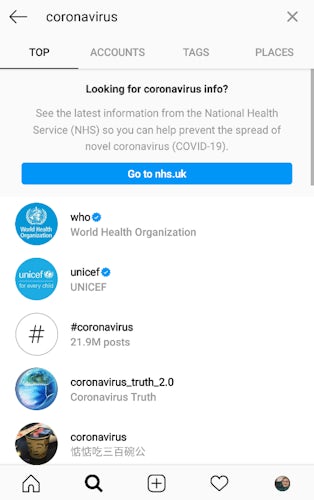
Instagram makes sure to promote authoritative sources of coronavirus information in its search results. (Image via Instagram)
Unfortunately, some dubious accounts are still able to appear pretty high up on the search results for these terms (as you can see from the above screenshot) indicating the system that flags content could do with being a bit more robust.
Away from combatting misinformation, those using Instagram’s video calling function are now able to ‘co-watch’ together. This allows multiple people on the same call to simultaneously browse through and discuss posts one user has liked or saved, creating a new shared experience in social content consumption.
Instagram has also introduced new stickers, which can be used on Stories, to encourage users to embrace social distancing and ‘shopping small’ during the pandemic. In turn, stories from accounts you follow featuring such stickers are pushed to the top of users’ feeds, keeping these sentiments in front and centre of mind.
In March, the Stay Home sticker was introduced and saw huge uptake, with users from all over the world sharing sneak peaks into their daily lives from the safety of their homes. To date, the hashtag of the same name has 33.6 million Instagram posts attached to it.
Later came the Support Small Business stickers in early May, which link through to a chosen Instagram account and can include up to three in-feed images to endorse certain products. These work particularly well on a localised level than some of the more generic Instagram stickers available, as they help promote stores, artists and creators that may otherwise struggle in this turbulent time.
How social media platforms are helping small businesses amid Covid-19
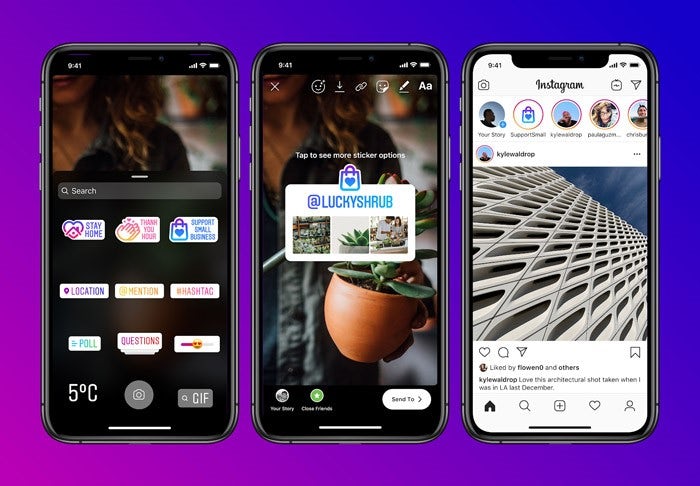
Instagram has given its users the ability to support small businesses with stickers. (Image via Instagram)
Other variations that have gained traction on the platform are the #IStayHomeFor and ‘Thank You’ stickers, which are commonly used to celebrate the dedication of healthcare and other key workers. There’s also a Covid-19 donation sticker with a helpful search function that allows you to browse non-profits under the title ‘helping to fight Covid-19’.
How has usage changed?
Twitter has seen much the same picture as Facebook and Instagram when it comes to levels of engagement and a dip in advertising revenue growth.
According to Twitter’s Q1 2020 results, the platform saw it’s ‘strongest ever’ year-on-year growth of global monetizable Daily Active Users (mDAU) – up 24% from 134 million in the first quarter of 2019 to 166 million in Q1 2020. Total ad engagements increased by 25% year-on-year.
The types of topics users discussed in the first quarter took a dramatic turn as populations acclimatised to the new normal. Global conversations about coronavirus quadrupled in the month of March, according to insight from SproutSocial, and tweets about cooking jumped by 60% in the US between 9th-22nd March compared to the two weeks prior. Meanwhile, global conversation volume related to gaming rose by 71% in the last two weeks of March alone.
However, the coronavirus has taken quite a toll on Twitter’s ad revenue, as it reported a neutral growth (0%) year-on-year or a -23% hit when measured quarter-on-quarter. Cost per engagement also plummeted by 19% as advertisers pulled back their spending amidst growing financial uncertainty for many brands.
How is it supporting its users in light of Covid-19?
Like others, Twitter is attempting to control the sharing of misinformation by prioritising content from reputable sources such as government departments and health organisations. Its Know The Facts search prompt was introduced at the end of January and is now implemented in 50 different countries across the globe, ensuring those that are seeking it are able to obtain accurate information.
We want to help you access credible information, especially when it comes to public health.
We’ve adjusted our search prompt in key countries across the globe to feature authoritative health sources when you search for terms related to novel #coronavirus. pic.twitter.com/RrDypu08YZ
— Twitter Public Policy (@Policy) January 29, 2020
Due to the sheer volume of conversation around the pandemic, the platform has employed further automated technology to help identify misleading posts more efficiently than usual. However, because fewer human eyes are dedicated to content enforcement, Twitter has readily admitted that mistakes may occur when flagging or removing content it deems to violate its terms. In order to avoid errors as much as possible, the company has since instigated a daily quality assurance check on this function and will not permanently ban accounts for posting any content that is flagged by the new system.
Towards the beginning of the year, Twitter began labelling manipulated media in an effort to make its users more aware of potentially deceptive content. These labels often appear as warnings beneath the post with a link to trusted external sources that provide further context. Now, since the outbreak, this feature has been adapted to caution users against misleading material about the coronavirus.
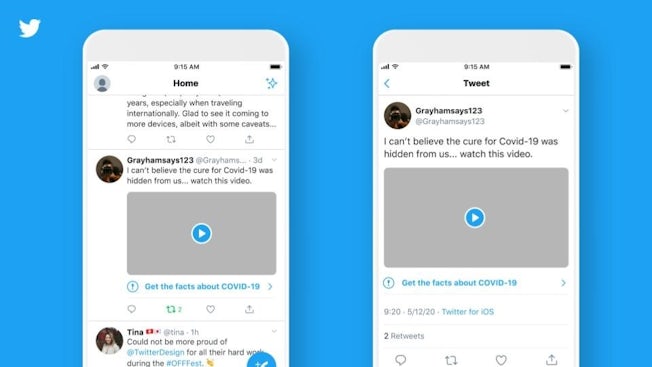
Twitter is using warning labels to make users more aware of potentially deceptive content. (Image via Twitter)
Of course, Twitter has always been a hotbed for the sharing of misleading content, even when compared to other social media apps. A study conducted by Oxford University found that nearly 60% of Covid-19 content, which had been flagged as false by fact-checkers between January and March, was not taken down by the company.
While this figure may well have improved in the following months, reports claim that it remains as unchecked as ever, with some cases featuring verified accounts with thousands of followers sharing posts promoting conspiracy theories.
Therefore, it could be argued that the platform could do much more to help protect its users from false claims. One obvious example would be implementing a reporting function that specifically cites coronavirus misinformation as an issue – however, it appears that no changes of this kind have been made so far by the company.
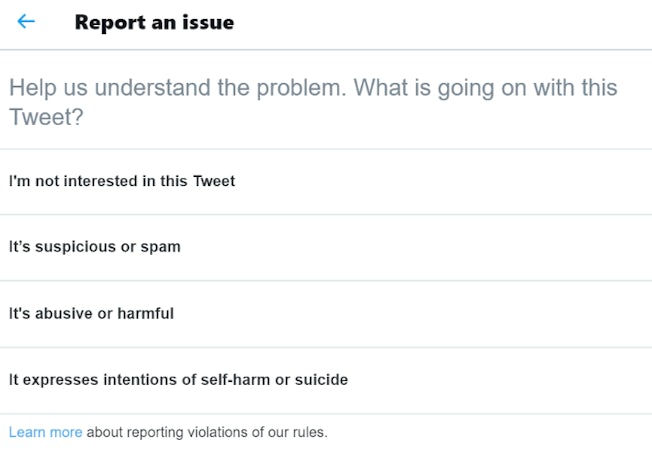
Twitter has yet to add misinformation to its list of options for reporting a tweet. (Image via Twitter)
Snapchat
How has usage changed?
In its Q1 2020 results, Snap Inc. reported a 20% year-on-year rise in Daily Active Users, with an average of more than 4 billion snaps created every day between January and March. As a result, total daily time spent on the platform increased by around 35% year-on-year and the number of users watching ‘Shows’ more than doubled compared to the same period in 2019.
During the last week of March, communication with friends – for example, snaps and messaging – rose by more than 30% when compared to the final week of January. This figure increased to more than 50% in geographic areas most heavily affected by the virus. Furthermore, the company recorded a 36% month-on-month surge in install volume for app ads and a 19% rise in swipe-ups on ads towards the end of March compared to the end of February.
Snapchat stated in its press release, ‘we are grateful for the opportunity to help Snapchatters communicate with their loved ones amid the Covid-19 pandemic’.
How is it supporting its users in light of Covid-19?
Snapchat has adapted its relatively new Here for You feature, launched in February, to help provide information about the coronavirus. Originally, Here For You was designed to support Snapchatters’ mental health by providing advice and resources on topics such as bullying and anxiety.
Consequently, a ‘special edition’ of the Here For You feature has been added to the platform which contains snaps from official health organisations, as well as celebrities, covering various snippets of advice and information about the disease.
Presented in a quick-fire format, as per standard snaps, the content is educational, yet easy to follow, and doesn’t require too much effort on the part of the viewer. There’s also a useful ‘subscribe’ button which allows the app to notify you of any additional snaps added to the feature in the future.
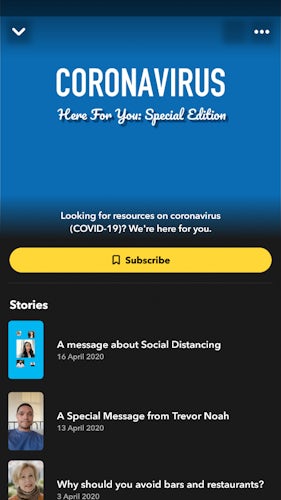
Snapchat has adapted its Here For You support feature for the coronavirus crisis. (Image via Snapchat)
In April, the platform also announced it would be adding a brand new lens to its library which functions as an AR donation experience. Users can scan up to 23 different currency notes from around the world and watch as the lens explains how donations to the WHO Covid-19 relief fund help patients with the virus, as well as provide medical workers with the equipment they need. At the end of the experience, Snapchatters can donate via the app.
Snapchat’s efforts to keep its users informed of the ongoing pandemic in a succinct way have been significant. As of 21st April, it had published more than 700 Discover editions covering Covid-19 news created by both its in-house team and the CDC and WHO to name a few. Despite mostly serving as an alternative messaging platform, Snapchat seems to have gone the extra mile to ensure that reliable information is easily available to its users if they require it.
Lastly, when it comes to entertainment, the brand has produced its fair share of original content since the outbreak began, including Nikita Unfiltered and Will From Home, which features “Will Smith hanging out in his garage as he shares his own shelter-in-place experience along with his friends”. The former has received more than 20 million views to date, proving that Snapchat can make longer form content that is just as engaging as its short form content.
Conclusion
Considering the speed at which the pandemic has developed over a short period of time, it is reassuring to see that, across the board, social media platforms are adding useful updates in a timely and sensitive manner. They have also evidently been monitoring the ongoing situation and adapting or further adding new functionality as and when it’s needed.
However, it is easy to identify platforms that have implemented a more comprehensive strategy when it comes to keeping their users supported and accurately informed, while others could perhaps benefit from deeper consideration.
Stats roundup: coronavirus impact on marketing, ecommerce & advertising

Comments